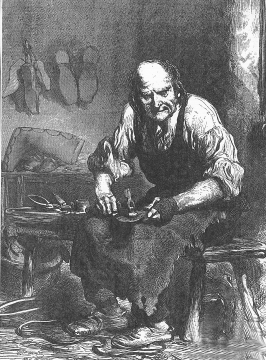
The term "cordwainer" is an Anglicization of the French word cordonnier, which means shoemaker, introduced into the English language after the Norman invasion in 1066. The word was derived from the city of Cordoba in the south of Spain, a stronghold of the mighty Omeyyad Kalifs until its fall in the 12th century. Moorish Cordoba was celebrated in the early Middle Ages for silversmithing and the production of cordouan leather, called "cordwain" in England. Originally made from the skin of the Musoli goat, then found in Corsica, Sardinia, and elsewhere, this leather was tawed with alum after a method supposedly known only to the Moors. Crusaders brought home much plunder and loot, including the finest leather the English shoemakers had seen. Gradually cordouan, or cordovan leather became the material most in demand for the finest footwear in all of Europe. 
The English term cordwainer first appears in 1100. Since this date the term cordouan, or cordovan leather, has been applied to several varieties of leather. Today cordovan leather is a vegetable tanned horse "shell," and like the Medieval cordwain is used only for the highest quality shoes.
Since the Middle Ages the title of cordwainer has been selected by the shoemakers and used loosely. Generally it refered to a certain class of boot and shoemakers. The first English guild who called themselves cordwainers was founded at Oxford in 1131. "Cordwainers" was also the choice of the London shoemakers, who organized a guild before 1160, and the Worshipful Company of Cordwainers has used this title since receiving its first Ordinances in 1272.
The first English cordwainers, or shoemakers, landed at Jamestown, Virginia, established in 1607-- the first permanent English settlement on this continent, from which began the overseas expansion of the English-speaking peoples, the earliest outpost of the British Empire and the first beginnings of the United States of America.. Captain John Smith has been alleged to have been a cordwainer, but this is unlikely. This historic adventure of settlement was in part supported by investments made by the London cordwainers.
Shoemakers, tanners, and other tradesmen arrived in Jamestown by 1610, and the secretary of Virginia recorded flourishing shoe and leather trades there by 1616. The first English shoemaker to arrive in America whose name has been preserved, was Christopher Nelme, who sailed from Bristol, England and reached Virginia in 1619. Nearly one year later, the first Pilgrim settlers landed in Massachusetts. The first shoemakers who followed the trade there arrived in 1629.
A distinction preserved by cordwainers since the earliest times is, that a cordwainer works only with new leather, whereas a cobbler works with old. Cobblers have always been repairers, frequently prohibited by law from making shoes. Going so far as to collect worn-out footwear, cut it apart, and remanufacture cheap shoes entirely form salvaged leather, cobblers have contended with cordwainers since the Middle Ages. In 16th-century London, the cordwainers solved their conflicts with the cobblers of that city by placing them under the authority of the cordwainers’ guild, thus merging with them.
Whenever shoemakers have organized, they have shown a clear preference for the title cordwainer, conscious of the distinguished history and tradition it conveys. Today's cordwainer is no exception. The current generation of boot and shoemakers includes a growing number of tradesmen and tradeswomen, who having largely adopted traditional hand-sewn techniques supplemented by simple machines, continue to practice skills established centuries ago. In the face of declining domestic footwear production, it can easily be said that the future of this trade lays in its past, and is being insured by the these modern cordwainers.